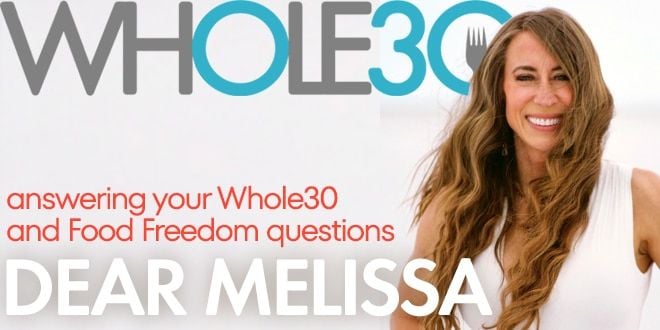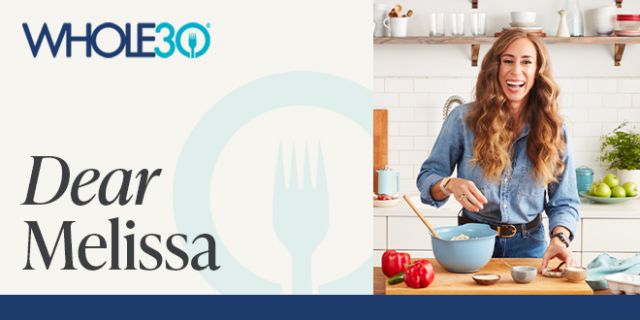The Whole30 has changed millions of people’s lives since its inception in 2009. You can read page after page of glowing testimonials from our community, and many medical doctors, mental health practitioners, and other healthcare providers endorse the program and recommend it to their patients and clients. There are now eight Whole30 books, hundreds of free resources on our website, and just as many podcasts, print interviews, and television clips about the program.
And still, Whole30 misconceptions persist.
I get it—diet culture has imprinted on all of us that the only reason someone would change the food they put on their plate is to make themselves smaller, and it’s hard to disassociate any dietary plan from weight loss. If you heard about the Whole30 from your sister’s best friend’s hairdresser, saw a quick clip about it while scrolling through TikTok, or read a poorly researched article using “Whole30” in the title as clickbait, you might have some misconceptions about the program, too.
Today, I’ll outline six common Whole30 misconceptions, so you can make sure the program is a good fit for your context and goals.
1. The Whole30 is a weight loss diet.
The Whole30 was not designed for weight loss, and it is not a weight-loss program. You don’t restrict calories, track calories, or weigh and measure your food on the program. You don’t skip meals, fast, or replace meals with shakes. You eat to satiety, add snacks where needed, and include a balance of all three macronutrients (protein, fat, and carbohydrates) with every meal.
During the program, participants are encouraged to focus on non-scale victories (NSVs) instead of their body weight or measurements. In fact, one of the Whole30 program rules says you’re not allowed to step on the scale or take measurements during your 30 days. This encourages participants to focus on all of the benefits that can occur when you change the food you put on your plate—and provides you with a much-deserved break from the tyranny of the scale. However, people do come to the Whole30 hoping to lose weight, or with weight loss as a goal. We honor your right to do with your body as you choose. However, we do not provide support, guidance, or encouragement around weight loss or how to tailor the Whole30 for weight loss, and encourage you to embrace a different mindset around food, your body, and the impact of your diet on your physical and mental health.
2. The Whole30 isn’t sustainable.
The program is called the Whole30, not the Whole365. The Whole30 isn’t meant to be sustainable. It’s not prescriptive, in that we don’t tell you how you should eat forever. In fact, the Whole30’s entire premise is that there is no “one-size-fits-all” when it comes to diet! That’s why we provide the framework to help you figure out what works best for you, rather than an “eat this, not that” directive.
The Whole30 is a short-term elimination diet, designed to identify food sensitivities, create new habits, and restore a healthy relationship with food. The elimination program should be followed for 30 days, plus a 10-15 day period for reintroduction. Following reintroduction, you’ll have enough knowledge about the way food groups work in your unique body to create a long-term, satisfying diet that works best for you.
We want you to achieve true food freedom, and you won’t get there if you continue to follow the Whole30 rules forever. Plus, following the Whole30 for months or years would mean you’d miss out on some truly special, culturally significant, downright delicious foods. Ideally, participants will do the Whole30 (perhaps a few times over the course of a few years), then apply what they’ve learned and never need to do the program again, because they’d be comfortably implementing their own dietary best practices.
3. The Whole30 cuts out healthy food groups like whole grains and dairy.
It’s easy to look at the Whole30 program rules and assume we’re eliminating certain food groups for 30 days because they’re “bad.” That’s what diet culture has taught us: that some foods are universally good while others bad, and we are good or bad based on what’s on our plate.
However, there are no universally healthy or unhealthy foods, and the Whole30 doesn’t eliminate food groups because they’re bad. There are plenty of benefits to eating whole grains or dairy—if you tolerate those foods well. But lots of people don’t, and if eating whole wheat makes your joints swell or eating dairy makes your asthma worse, those foods may not be health-promoting for you.
The Whole30 eliminates certain food groups because they’re unknown. The scientific literature and our 14 years of clinical experience demonstrate that these food groups can be problematic for many people, to varying degrees. To determine how they work in your unique system, you’ll eliminate them for 30 days, reintroduce them carefully, and compare your experience.
If you discover that whole-grain bread, oatmeal, Greek yogurt, or ice cream doesn’t have a negative effect (or that it does, but it’s worth it given how much you love those foods), you’ll continue eating and enjoying them after your Whole30 is over. That’s what we call “your food freedom.”
4. The Whole30 is unnecessarily strict.
It’s worth clarifying why doctors and healthcare providers recommend that dietary elimination programs are strictly adhered to: When you’re trying to identify food sensitivities, the best health outcomes occur when you commit to strict observance of the protocol.
During the elimination phase, you’ll be omitting food groups that are commonly problematic in an attempt to discover whether they’re problematic for you. In order to evaluate how these foods might be impacting your sleep, energy, digestion, skin, joints, allergies, asthma, migraines, or anxiety, you’ll conduct a short-term scientific experiment: 30 days of complete elimination of these “test” food groups, then 10-15 days of careful reintroduction. By following the program with 100% compliance, you’ll be able to most accurately compare how you feel without these foods to how you feel when you eat them.
If you eat or drink something from the elimination group during those 30 days, we do recommend you start the program over, as do our medical advisors. It’s important to allow yourself the full 30 days to experience the health changes that can occur when you remove potentially problematic food groups, and from a psychological perspective, we want participants to feel the sense of self-confidence that comes with making a promise to yourself—then keeping it.
5. You’ll miss out on key nutrients.
There are often concerns around whether participants will get enough fiber, vitamins, or calcium on the Whole30. It’s a common misconception that you need grains or beans in your diet for fiber, or dairy for calcium. (What is everyone with lactose intolerance supposed to do, then?)
However, we’ve done many nutritional comparisons between a typical Whole30 day of eating and the USDA’s “My Plate” recommendations (one outlined in my first book, It Starts With Food, and the most recent in partnership with U.S. News and World Report)—and the Whole30 comes out on top in nearly every category.
There is plenty of fiber in the vegetables and fruits you’ll eat on the program, not to mention they’re a far more dense source of vitamins and minerals than bread or cereal. And even without dairy, you’ll find calcium from bone broth, leafy greens (like kale), nuts, and seeds. In addition, you’ll eat far less added sugar and sodium on a Whole30 plan, because you’re eliminating so many processed foods.
Remember, the program is only 30 days. If you do have specific concerns about your micronutrient intake based on your health context or lab work, consult your healthcare provider to create a supplement plan that is right for you.
6. There is no support after your 30 days.
The easiest Whole30 misconception to refute is that the program abandons you once your 30 days are over. That might happen with weight-loss diets, but not with the Whole30! In fact, there is a whole book about how to take what you’ve learned during the Whole30 and turn it into a lifetime of healthy habits. It’s called Food Freedom Forever, and it outlines my three-part plan for using what you’ve learned on the Whole30 to create a long-term, satisfying, sustainable diet according to your definition of health.
The Whole30 also offers tons of free support for this phase of your Whole30—on social media, in newsletters, and on our website. In fact, most people choose to stay connected to our community long after their Whole30 is over. Continuing to share about your Whole30 experience and help others navigate their program reinforces the healthy habits you learned during the program, and provides you with resources, tips, and motivation for continuing to refine your food freedom plan.
Discover the truth about Whole30 for yourself
I’ve welcomed the opportunity to share the facts around some of these common Whole30 myths, and I hope you’ve learned more about the structure and benefits of an elimination program like ours. While the Whole30 isn’t right for everyone, my team and our enormous, positive, supportive community would love to welcome you into our community if you decide to give the program a try. Share this article or the video above with someone you’d like to do the Whole30 with, and sign up for our free Whole30 starter kit and email resources here.
Disclaimer: This page contains affiliate links. We earn a small commission when you purchase through these links.














